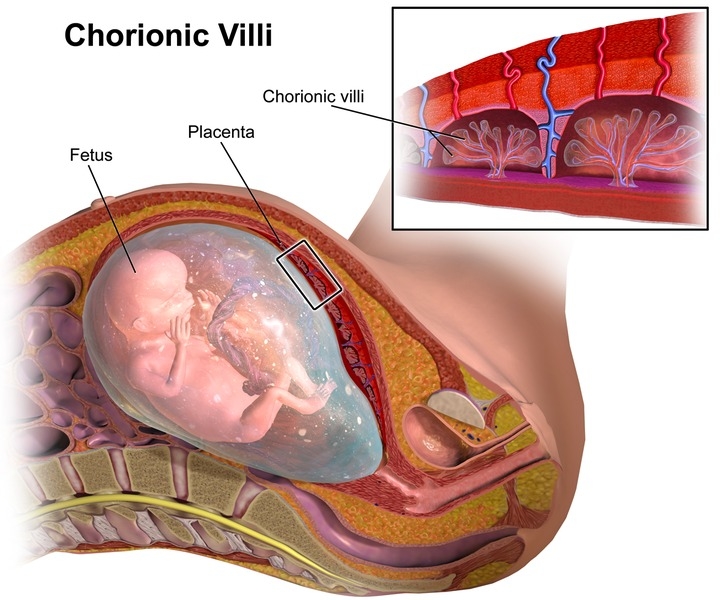
All About Chorionic Villus Sampling (CVS) Testing During Pregnancy
16 Jul 2018 | 4 min Read
Babychakra
Author | 1369 Articles
Chorionic Villus Sampling or CVS is a prenatal test performed during pregnancy to rule out congenital defects in the baby growing in your womb. Also called as chorionic villus biopsy, this test involves taking a sample of chorionic villi cells from the placenta for testing.
Known to rule out or diagnose birth defects, genetic diseases, and chromosomal abnormalities like the Down Syndrome during pregnancy, CVS is usually suggested between 11 to 13 weeks of pregnancy to women who have a high risk of giving birth to a baby with genetic disorders so that the problems can be detected early on. CVS is not advised before 10 weeks of pregnancy.
Reasons Why Your Doctor Can Suggest a CVS Testing
CVS is considered 98% accurate in diagnosing chromosomal defects. This procedure also figures out the sex of the baby, which in-turn can help rule out or diagnose specific abnormalities associated with that sex. For instance, muscular dystrophy, which is a progressive weakening of muscles, is more common in males. Here’s a look at the circumstances when your doctor may recommend that you go through a CVS test.
• When you or your partner have a family history of disorders like cystic fibrosis or muscular dystrophy
• If you have had spontaneous abortions despite taking good care
• If you will be 35 years or older on your due date, you may be more prone to having a baby with a chromosomal problem like Down syndrome
• If your previous pregnancy was unfortunately marred with foetal abnormalities or when your baby was born with a mental health condition or chromosomal defect
• When an early ultrasound suggests your baby may have structural defects as a result of a chromosomal problem
• When a previous antenatal screening test has indicated the possibility of a problem such as sickle cell anaemia, a genetic blood disorder.
How Does CVS Work During Pregnancy?
In the initial stage of pregnancy, the fertilised egg or embryo divides into two parts, one of which develops into the baby and the other forms the placenta. The part of the embryo that forms the placenta and has tiny finger-like projections on it are termed as ‘chorionic villi’.
Since these sections are created by the division of the fertilised egg and feature the same DNA as the embryo, they would also carry any possible genetic abnormality. If the chorionic villi indicate a congenital abnormality, the same will also be present in the developing baby.
How is CVS Testing Performed?
Before performing the CVS test, it is important to provide genetic counselling, which will include an in-depth explanation of the method, risks, and benefits of the procedure. An ultrasound examination must be done to confirm the stage of pregnancy you are in so that the chorionic villi sample obtained from you is good enough to provide the results.
The idea behind the CVS test is to derive a small sample of the tissue from your placenta through the cervix or abdomen. The doctor chooses the approach that will provide the best access to your placenta. The sample is then sent to the laboratory for analysis. The cells are cultured in a special fluid for testing a few days later.
Let’s take a quick look at the two ways of obtaining the chorionic villi cells from the placenta.
A. Transabdominal CVS
After administering local anaesthesia to the patient, a thin needle is inserted through the abdomen to the placenta, making sure the process is monitored continuously by ultrasound. The needle does not pass through the amniotic sac or goes anywhere near the baby.
B. Transcervical CVS
A speculum is inserted through the vagina into the cervix. Upon observation by ultrasound, the tube is guided up to the placenta and a small sample is sucked out.
Rule Out Foetal Abnormalities with CVS if Your Doctor Has So Advised
Follow your doctor’s advice for getting a CVS test done to diagnose or eliminate the possibility of birth defects and other genetic disorders in your unborn child. Do not delay and ensure the test is performed within the timeline specified by your gynaecologist.
The process could be a bit painful but it does not take too long to finish. It is possible to extract the sample within minutes. A little cramping and bleeding following the procedure is normal so do not panic at the sight of blood.
Make sure you take rest after the procedure for the remaining part of the day and restrict yourself from any physical activity. In case you notice anything unusual such as fluid leakage from the vagina, consult your doctor immediately.
Also read: Congenital Birth Defects
A


Related Topics for you
Suggestions offered by doctors on BabyChakra are of advisory nature i.e., for educational and informational purposes only. Content posted on, created for, or compiled by BabyChakra is not intended or designed to replace your doctor's independent judgment about any symptom, condition, or the appropriateness or risks of a procedure or treatment for a given person.
